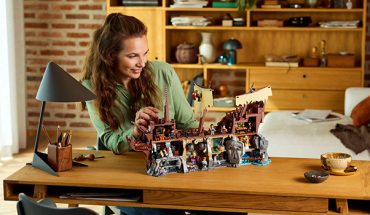For several years, I have had an outdoor TV on the back deck. When my partner first brought it home, I was reluctant. Why would we even need one? But over the years, I have realized the value it offers and why having a TV outside is actually a worthwhile investment. You may recognize the same, too, once you get on board.
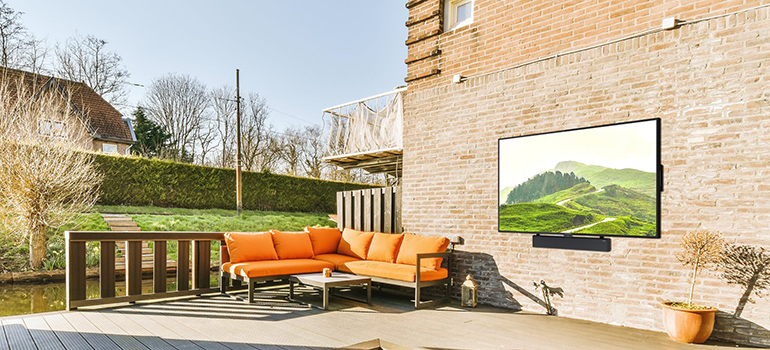 What is an Outdoor TV?
What is an Outdoor TV?
An outdoor TV isn’t just taking a flat-screen TV, mounting it outside, and calling it a day. Outdoor TVs are specially designed to for use outdoors, to withstand extreme temperatures, inclement weather, and handle direct sunlight.
Rugged Build – Outdoor TVs are designed to withstand inclement weather, including everything from rain to snow, as well as extreme temperatures, from humidity to the frigid cold. While you should always keep one covered when it isn’t in use, you don’t have to worry if you forget to cover it one night, or it starts to pour while you’re on the deck watching the game. We have left an outdoor TV uncovered for weeks at a time through rain, snow, and 30°C summer heat and it continues to work beautifully.
Covered Ports – These TVs have ports that are covered and sealed to ensure that dust, debris, moisture, water, and other items don’t get inside. This makes it a bit more challenging to connect things like a streaming stick. But it also keeps them running properly on your deck just like they would in your living room.
Screens – The screens on outdoor TVs are designed to be viewable even in direct sunlight, with brightness levels that are different from a traditional living room TV to compensate for the added ambient light.
Why and When Would You Use One?
You might think there’s no purpose for an outdoor TV. Isn’t outdoor time supposed to be about being active and disconnecting from technology? It absolutely is. You should enjoy tossing a ball around with the kids in the backyard, having conversation with friends while hosting a barbecue, or relaxing in a hammock with a good book. But there are times when you’ll find that an outdoor TV was worth every penny.
The Big Game – Ever hosted a barbecue in the summer when the big game is on, or an important match-up during the Olympics? Chances are, half your guests take an odd number of “bathroom breaks” to secretly head inside to check the score or status on the TV. Or they might have their heads buried in their phones to keep on top of the score. Put the game or event on the outdoor TV, and everyone can check in periodically while remaining part of the conversation.
Weekend Breakfast and Dinner – Often times, my family barbecues dinner in the summer, or weekend lunches. We’ll sit outside and enjoy the sunshine while it’s cooking, and sometimes put on a TV show while we eat. Usually, it’s an interactive show we can converse about, like a game show or talent competition show. It’s a nice respite from sitting on the couch in the living room.
Working From Home – So many of us work from home nowadays, either entirely or partially. If you’re like me, you might love to sit on a covered deck with your laptop every now and then to enjoy the lovely midday weather. Turn on an outdoor TV to keep on top of the news via a channel like CP24 (just make sure to change the channel every now and then to avoid burn-in!) Maybe you want to put on stock updates or even connect the TV for a Zoom call in the sunshine.
Viewing Events – Rather than take a TV and move it to the garage to invite the neighbours over to watch the game, invite them to watch outside where they can enjoy a few beers under the stars and not worry about disturbing the kids sleeping inside. There are summer nights when I’ll sit outside with a cold drink and my feet up watching TV on the back deck rather than in the living room to soak up every ounce of the season. Just make sure to have citronella candles nearby if mosquitoes are an issue.
What to Consider Before Buying One
Before buying an outdoor TV, there are a few things to consider.
Size – Make sure to measure the spot where you will mount it to ensure that it will fit nicely. This includes not only width and height but also depth. If it’s being mounted to a deck, check that there are slats where it can be safely positioned. You might want to consider having a professional do the mounting if you aren’t comfortable doing it yourself.
Wiring – As with any other TV, an outdoor TV requires power. You’ll need to run wires from the nearest outlet to the TV, so make sure you have a clear path to do this, or a method of running an extension cord that won’t get in the way.
Connectivity – Many outdoor TVs are smart TVs just like indoor ones, but this means they require Wi-Fi connectivity. You will need to position it close enough to be able to connect to your home Wi-Fi network. You can consider getting a Wi-Fi extender to place outside to avoid a chopping connection. But test placement first to ensure that Wi-Fi reaches to the TV. Unless you plan to place content on a USB flash drive or find another means, you’ll need a viable Wi-Fi source to play content.
Buy a Cover – Most outdoor TVs don’t come with a protective cover: you need to buy one separately. It’s worth investing in at the time of purchase to help prolong the life of the display, especially before the winter season.
Check the Weather Rating – Read through the TV’s specs and look into the operating temperatures, especially if you live somewhere that tends to get extremely hot or humid in the summer or especially frigid in the winter. Some TVs have higher ratings than others, so you’ll want to make sure it can withstand whatever possible temperatures your province or city may have.
Sun Placement – You’ll see outdoor TVs marked as full sun or partial sun. This is an important distinction. Partial sun outdoor TVs are designed for covered spots, like on a porch or veranda. They aren’t rated to be completely out in the open. By contrast, a full sun outdoor TV is meant for placement just about anywhere outside. You may also see full shade outdoor TVs, which are effectively one step above an indoor TV but not quite ready for all the elements. Naturally, full sun outdoor TVs are the most expensive.
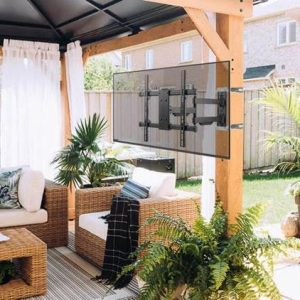 Mounting – Along with an outdoor TV, you will need a proper mount. Most if not all outdoor TV manufacturers offer mounts as well. But you can also get a third-party mount that offers features like tilt and swivel capabilities. Make sure to get a mount that’s rated for outdoor use as well, made from weather-proof materials, typically with a higher weight capacity. There are unique options as well, like the ZeboZap outdoor TV mount, which makes it easy to mount a TV in a gazebo, deck, or patio without the need for drilling. That’s because the mounting system wraps around a post, column, pillar, or beam, no matter its shape nor material. It can accommodate screens from 32 up to 70 inches in size from any brand. Enter for your chance to WIN a ZeboZap outdoor TV mount.
Mounting – Along with an outdoor TV, you will need a proper mount. Most if not all outdoor TV manufacturers offer mounts as well. But you can also get a third-party mount that offers features like tilt and swivel capabilities. Make sure to get a mount that’s rated for outdoor use as well, made from weather-proof materials, typically with a higher weight capacity. There are unique options as well, like the ZeboZap outdoor TV mount, which makes it easy to mount a TV in a gazebo, deck, or patio without the need for drilling. That’s because the mounting system wraps around a post, column, pillar, or beam, no matter its shape nor material. It can accommodate screens from 32 up to 70 inches in size from any brand. Enter for your chance to WIN a ZeboZap outdoor TV mount.
What Brands Offer Outdoor TVs?
There are specialty brands that offer outdoor TVs, like Sunbrite and Furrion, as well as bigger TV brands that make their own outdoor models, too, like Samsung. In fact, many major TV brands offer outdoor TV models in their commercial lines that are designed for places like restaurant patios and rated to run for long periods of time per day. But there are consumer-level models to consider, too.
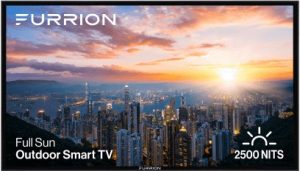 Furrion recently launched its new Aurora Full Sun Pro Series 4K LED outdoor TV, which comes in 55-, 65-, and 75-inch sizes. It offers increased brightness at 2,500 nits, 4K resolution, and an IP66 rating. Optical Bonding technologies remove air gaps to ensure durability, while the screen is impact resistant with an anti-scratch coating and industrial heat sinks. It comes with the webOS smart TV platform built in but also has three HDMI ports, two USB, optical, and RJ45. Pricing is steep, however, at US$8,000 to US$11,000.
Furrion recently launched its new Aurora Full Sun Pro Series 4K LED outdoor TV, which comes in 55-, 65-, and 75-inch sizes. It offers increased brightness at 2,500 nits, 4K resolution, and an IP66 rating. Optical Bonding technologies remove air gaps to ensure durability, while the screen is impact resistant with an anti-scratch coating and industrial heat sinks. It comes with the webOS smart TV platform built in but also has three HDMI ports, two USB, optical, and RJ45. Pricing is steep, however, at US$8,000 to US$11,000.
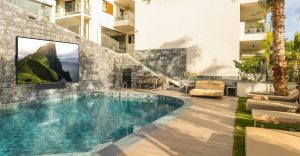 Introduced at CES 2024, Skyworth’s Clarus S1 UHD Full Sun outdoor miniLED TV comes with Google TV built-in, 3,000 nits brightness, an IP66 rating, 4K resolution, and a bundled 100W soundbar that mounts underneath it. It’s about half the price at US$5,000.
Introduced at CES 2024, Skyworth’s Clarus S1 UHD Full Sun outdoor miniLED TV comes with Google TV built-in, 3,000 nits brightness, an IP66 rating, 4K resolution, and a bundled 100W soundbar that mounts underneath it. It’s about half the price at US$5,000.
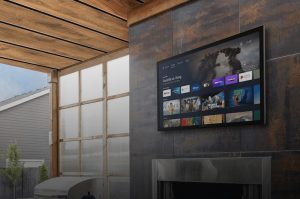 For a covered porch, you could consider the SunBrite 55-inch Veranda 3 Series smart outdoor TV, which is rated as a full shade model. It offers 4K resolution and 1,000 nits brightness, and comes housed in an IP55-rated aluminum weatherproof exterior that can handle rain, snow, dust, and humidity. It isn’t quite as rugged as the others, but it’s much more affordable at under US$2,000.
For a covered porch, you could consider the SunBrite 55-inch Veranda 3 Series smart outdoor TV, which is rated as a full shade model. It offers 4K resolution and 1,000 nits brightness, and comes housed in an IP55-rated aluminum weatherproof exterior that can handle rain, snow, dust, and humidity. It isn’t quite as rugged as the others, but it’s much more affordable at under US$2,000.
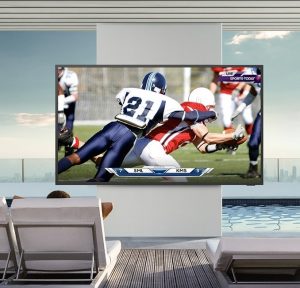 Samsung’s The Terrace TVs come in 65-inch, 75-inch, and 85-inch variants. Designed for direct sun protection, it’s resistant to all types of weather via the IP55 rating, and come with smart TV functionality built in. Offering 1,500 nits brightness and 4K picture quality along with anti-reflection technology to help reduce glare, Samsung still recommends to install it in a shaded area.
Samsung’s The Terrace TVs come in 65-inch, 75-inch, and 85-inch variants. Designed for direct sun protection, it’s resistant to all types of weather via the IP55 rating, and come with smart TV functionality built in. Offering 1,500 nits brightness and 4K picture quality along with anti-reflection technology to help reduce glare, Samsung still recommends to install it in a shaded area.
Ready for Movie Night?
Ready for your outdoor movie night, viewing party, or quiet Sunday dinner with the family outside while you watch the baseball game or check out the Euro Cup? Consider getting an outdoor TV to combine the experience with the great outdoors. Alternatively, if you don’t want a permanent outdoor TV set-up, you can also consider a portable projector.
See our tips for everything you need for a backyard movie night, and add an outdoor TV to that list if you think you’ll enjoy it like I do.
If you have decided to bite the bullet and get an outdoor TV, and you have a unique place you want to mount it, enter our contest for the chance to win a ZeboZap outdoor TV mount.
-30-
More on TV


